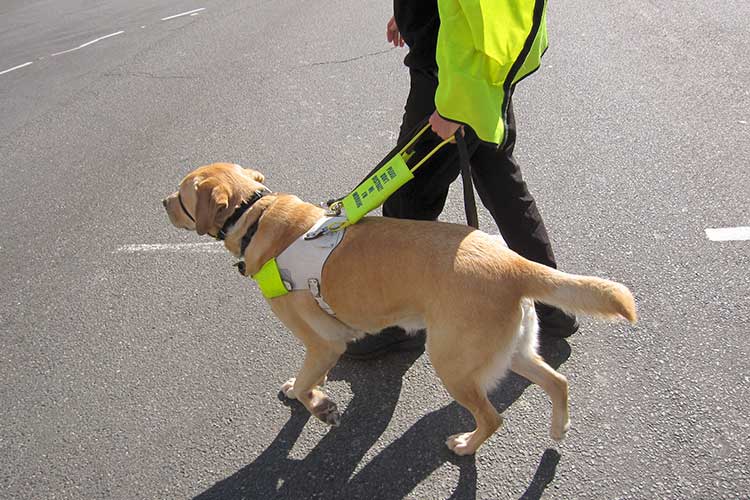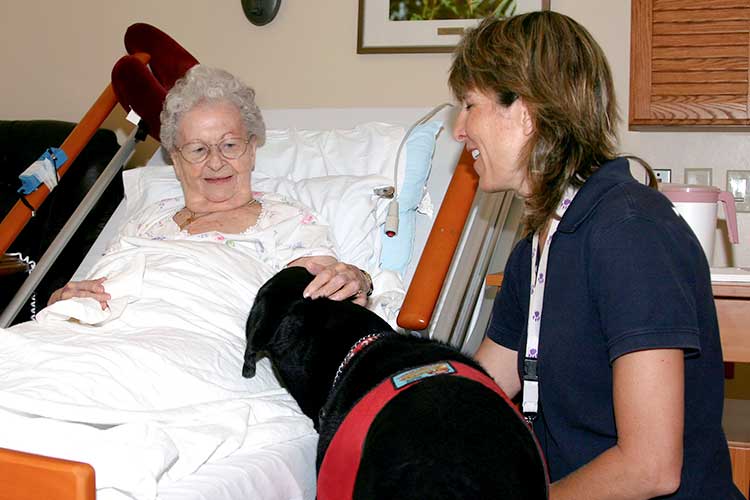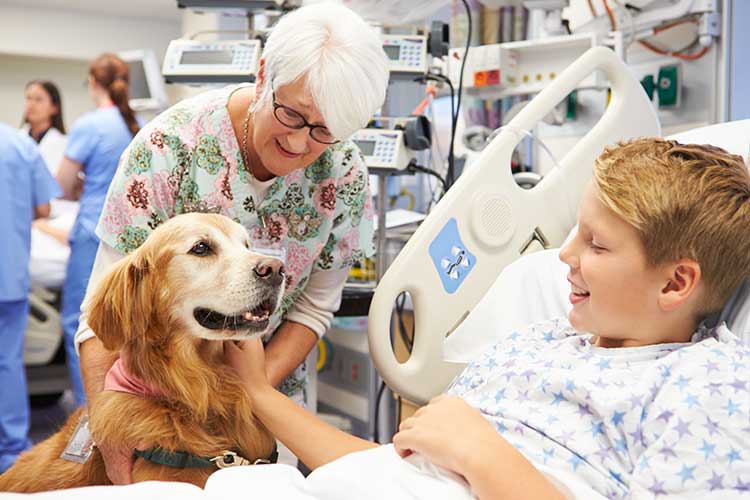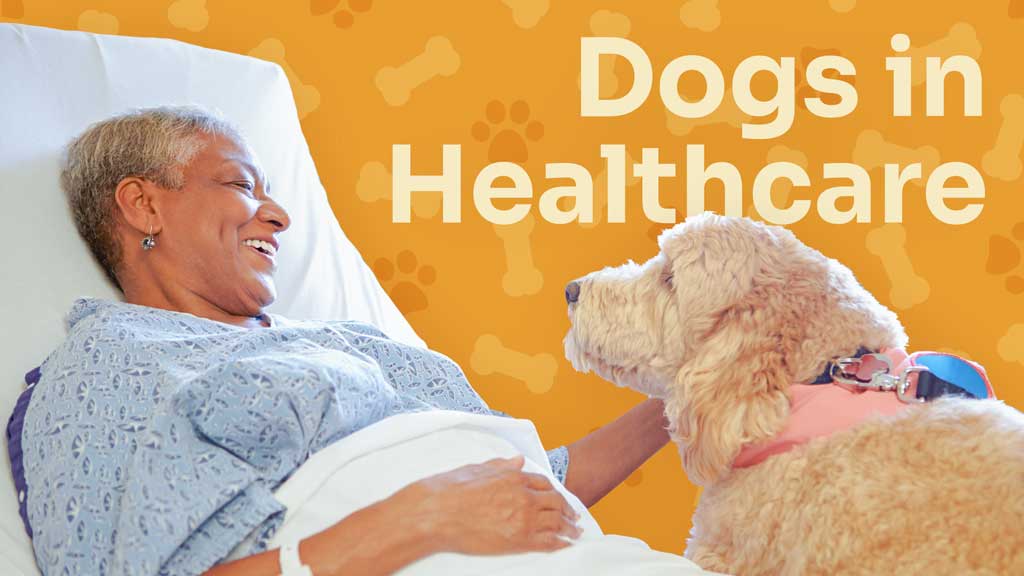You may be overjoyed to hear that interacting with dogs can have a variety of health benefits.
However, before you invite man’s best friend into your care facility, several considerations need to be made to ensure that clients, volunteers, visitors, staff and dogs can all have a safe and enjoyable experience.
Types of Dogs in Healthcare Settings
The main types of dogs that you may encounter in healthcare settings are:
- Assistance dogs that are specifically trained to perform tasks in order to assist a person living with disability. Examples of such tasks include:
- Assisting people with vision or hearing impairment
- Pulling wheelchairs
- Assisting with balance
- Turning lights on and off
- Opening and closing doors, drawers and fridges
- Assisting with making beds
- Retrieving or picking up objects or clothing
- Pushing pedestrian crossing buttons
- Alerting to danger
- Alerting to seizures, low blood sugar or other medical issues
- Alerting to allergens
- Finding and leading others to the owner
- Preventing impulsive or destructive behaviours related to psychiatric or neurological disability
- Animal-assisted therapy dogs that are trained to assist in individualised programs (under professional supervision) to improve people’s physical, social, emotional and/or cognitive functioning
- Therapy dogs that attend the premises alongside handlers for ‘meet and greet’ activities aimed to reduce people’s anxiety, improve self-esteem and encourage interaction
- Visiting or resident companion dogs (pets).
(Healthdirect 2023; SESLHD 2024; First2Care 2022)

Are Dogs Allowed in Healthcare Settings?
Under the Commonwealth Disability Discrimination Act 1992, assistance dogs have the right to be taken into public places (Healthdirect 2023). However, there may be an exception if the owner is in a space where their disability is being addressed by means other than the dog, or where there are strict sterility requirements (e.g. an operating theatre) (Assistance Dogs Australia 2022; Animal Welfare Victoria 2020).
Assistance dogs may also need to pass a Public Access Test (PAT) (depending on the jurisdiction) in order to prove they meet the minimum standards for public access rights. These include:
- Being non-aggressive
- Obeying commands
- Being quiet (not barking)
- Having experience in real-life situations
- Being calm in confined and crowded spaces
- Being calm in noisy and stressful situations.
(PTV 2019)
Unlike assistance dogs, ‘companion’, 'therapy' and 'emotional support' dogs are not recognised by Australian legislation and have no public access rights (Dog and Cat Management Board 2025; Canine Essentials 2016). Therefore, whether or not these dogs are permitted in healthcare settings and for what purposes is up to the discretion of an individual organisation.
Despite this, it’s reasonable to expect that other non-assistance dogs have basic ‘good manners’ and meet the same standards as assistance dogs when in public (Canine Essentials 2016).
What are the Benefits of Dogs in Healthcare Settings?
In addition to offering practical assistance with daily tasks (in the case of assistance dogs), animal interaction has several other physical, psychological and social benefits.
Studies have found that interacting with, stroking and petting animals lowers blood pressure and reduces levels of the stress hormone cortisol. Animals may also decrease loneliness, improve mood and help people feel socially supported (Better Health Channel 2015; NIH 2018).
Furthermore, people who own or interact with animals are overall more healthy than those who do not. Older people who interact with animals have been found to recover from illness and surgery more quickly, deal with stress more easily, and are less likely to experience heart disease (Aged Care Guide 2025).
In healthcare settings, interacting with animals may:
- Increase quality of life
- Encourage positive emotions and attitudes
- Increase energy levels
- Decrease tension, fatigue and confusion
- Re-engage people who are unresponsive to other therapies
- Help people feel needed and comforted
- Make a sterile healthcare environment feel more homely
- Have a soothing and calming effect
- Delay the effects of ageing by increasing physical activity, socialisation and mental function.
(Aged Care Guide 2025)

Risks Associated With Dogs in Healthcare Settings
While there are several benefits associated with the presence of dogs in healthcare settings, there are also three main areas of risk:
- Infection
- Allergies
- Health and safety.
(RCN 2025)
Let’s look at how each of these risk areas can be addressed.
Note: The following guidance mostly pertains to non-assistance dogs that are not protected by the Commonwealth Disability Discrimination Act 1992. Always refer to your local policies and procedures on animal visits.
Infection Control
It's possible, albeit highly unlikely, for dogs to transmit zoonotic pathogens such as methicillin-resistant Staphylococcus aureus, Clostridioides difficile, Campylobacter, Salmonella and even rabies virus to humans (Smith 2012; Murthy et al. 2015).
In order to minimise the risk of infection, it’s recommended that healthcare organisations:
- Disallow dogs experiencing illness or diarrhoea from entering the premises until they have received treatment and are cleared of their illness
- Ensure dogs are house-trained
- Ensure all clients, volunteers, visitors and staff perform hand hygiene after touching or toileting dogs
- Ensure healthcare staff always perform hand hygiene prior to and after entering clinical areas
- Ensure healthcare staff do not hold dogs against their uniform (to prevent contamination)
- Use personal protective equipment (PPE) to prevent clothing and staff uniforms from being contaminated
- Always use barriers such as sheets or towels if a dog is to sit or put its feet on a bed
- Never allow dogs near people’s faces
- Perform routine environmental cleaning and disinfection after dog visits
- Don PPE when cleaning dog urine or faeces, and immediately dispose of excretions in a sealed clinical waste bag
- Steam clean any furniture that is soiled by dog urine or faeces
- Have an action plan in place in the event of transmissible diseases
- Follow standard precautions when handling dogs, preparing dog food and cleaning dogs
- Only allow dogs to visit clients with surgical wounds if the wounds are sufficiently covered
- Disallow dogs from licking anyone
- Ensure dogs are clean and well-groomed prior to visitation
- Disallow dogs from entering intensive care units, emergency departments, operating theatres, sterile areas, food preparation areas, dining areas, maternity units and special care nurseries.
(WACHS 2025; SESLHD 2024; RCN 2025)
Allergies
Dog allergies are common. Before a dog is allowed on the premises, it should be determined whether any person in the facility has a significant dog allergy. If so, it’s important to consider where interactions with the dog will occur to reduce the risk of adverse reactions (RCN 2025).
If the dog is visiting only one specific person, the interaction might be most suitable in a separate room or cubicle. If the dog is visiting a group, a communal dayroom might be the most appropriate option (RCN 2025).
Health and Safety

Healthcare organisations allowing dogs into the premises should take reasonable steps to ensure the safety of clients, volunteers, visitors, staff and the dog itself (RCN 2025).
Visiting or resident dogs should be behaviourally sound. Ideally, dogs should be assessed by a qualified behavioural trainer to determine:
- The risk of injury (e.g. bites) to other animals and people
- The dog’s temperament
- Whether the dog is suitable to visit the specific healthcare environment
- Reactivity to noises, other animals and unfamiliar people.
(WACHS 2025)
It’s also essential to consider potential barriers people may have in relation to interacting with dogs, for example:
- Animal phobias or fears
- Religious or cultural beliefs
- Immunosuppression
- Contact precautions.
(WACHS 2025)
In order to minimise the risk of harm to people or dogs, it’s recommended that healthcare organisations:
- Always ensure dog visits are agreed to and consented to in advance
- Ensure dogs are on leash and under control at all times
- Require dogs to wear ID tags or jackets identifying them as assistance or therapy dogs
- Never leave dogs alone with any person other than their owner or handler
- Monitor the dog’s body language and behaviour to ensure it is comfortable at all times
- Immediately remove the dog from any situation that puts a person or the dog at risk of harm
- Limit visitation time (dogs should only work for up to three hours per day)
- Always ensure dogs are being treated appropriately
- Assess factors such as room layout, space, size of the dog, etc. prior to visitation
- Ensure the dog has access to shade, water and shelter, and that there are no toxic plants that could harm the dog.
(RCN 2025; WACHS 2025)
If there is any doubt about the dog, it should not visit (RCN 2025).
Any injuries involving a dog must be addressed immediately, and an appropriate incident reporting process may need to take place (WACHS 2025).
Test Your Knowledge
Question 1 of 3
Which one of these scenarios would most likely violate recommended infection control practices for dog visits in healthcare?
Topics
Further your knowledge
 Free
Free Free
Free Free
FreeReferences
- Aged Care Guide 2025, ‘The Benefits of Pet Therapy’, Aged Care Guide, 21 January, viewed 17 April 2025, https://www.agedcareguide.com.au/information/pet-therapy
- Animal Welfare Victoria 2020, Guide Dogs, Seeing Eye Dogs and Assistance Dogs, Victoria State Government, viewed 17 April 2025, https://agriculture.vic.gov.au/livestock-and-animals/animal-welfare-victoria/dogs/guide-dogs-seeing-eye-dogs-and-assistance-dogs
- Assistance Dogs Australia 2022, Welcoming Assistance Dogs, Assistance Dogs Australia, viewed 17 April 2025, https://www.assistancedogs.org.au/wp-content/uploads/2022/02/ADA032_Info_Sheet_Public_Access.pdf
- Better Health Channel 2015, Dog Walking - the Health Benefits, Better Health Channel, viewed 17 April 2025, https://www.betterhealth.vic.gov.au/health/healthyliving/dog-walking-the-health-benefits
- Canine Essentials 2016, Laws in Australia, Canine Essentials, viewed 17 April 2025, http://www.canineessentials.com.au/laws-in-australia/
- Dog and Cat Management Board 2025, Assistance Dogs, Government of South Australia, viewed 17 April 2025, https://dogandcatboard.com.au/dogs/assistance-dogs
- First2Care 2022, ‘Guide to Assistance Animals’, First2Care Blog, 4 May, viewed 17 April 2025, https://www.first2care.com.au/post/guide-to-assistance-animals
- Healthdirect 2023, Assistance Dogs, Healthdirect, viewed 17 April 2025, https://www.healthdirect.gov.au/assistance-dogs
- Murthy, R et al. 2015, ‘Animals in Healthcare Facilities: Recommendations to Minimize Potential Risks’, Infection Control & Hospital Epidemiology, vol. 36, no. 5, viewed 17 April 2025, https://www.cambridge.org/core/journals/infection-control-and-hospital-epidemiology/article/animals-in-healthcare-facilities-recommendations-to-minimize-potential-risks/7086725BAB2AAA4C1949DA5B90F06F3B
- National Institutes of Health 2018, ‘The Power of Pets: Health Benefits of Human-Animal Interactions’, News in Health, viewed 17 April 2025, https://newsinhealth.nih.gov/2018/02/power-pets
- Public Transport Victoria 2019, Assistance Animal Pass, Victoria State Government, viewed 17 April 2025, https://www.ptv.vic.gov.au/tickets/myki/concessions-and-free-travel/assistance-animal-pass
- Royal College of Nursing 2025, Working With Dogs in Health Care Settings, RCN, viewed 17 April 2025, https://www.rcn.org.uk/Professional-Development/publications/rcn-working-with-dogs-in-health-care-settings-uk-pub-011-943
- Smith, B 2012, ‘The ‘Pet Effect’ Health Related Aspects of Companion’, Australian Family Physician, vol. 41, no. 6, viewed 17 April 2025, https://www.racgp.org.au/afp/2012/june/the-pet-effect
- South Eastern Sydney Local Health District 2024, Companion and Assistance Animals in Healthcare Facilities, New South Wales Government, viewed 17 April 2025, https://www.seslhd.health.nsw.gov.au/sites/default/files/documents/SESLHDPR%20590%20-%20Companion%20and%20Assistance%20Animals%20in%20Healthcare%20Facilities.pdf
- WA Country Health Service 2025, Animals in the Health Care Setting Guideline, Government of Western Australia, viewed 17 April 2025, https://www.wacountry.health.wa.gov.au/~/media/WACHS/Documents/About-us/Policies/Animals-in-the-Health-Care-Setting-Guideline.pdf?thn=0
 New
New 
